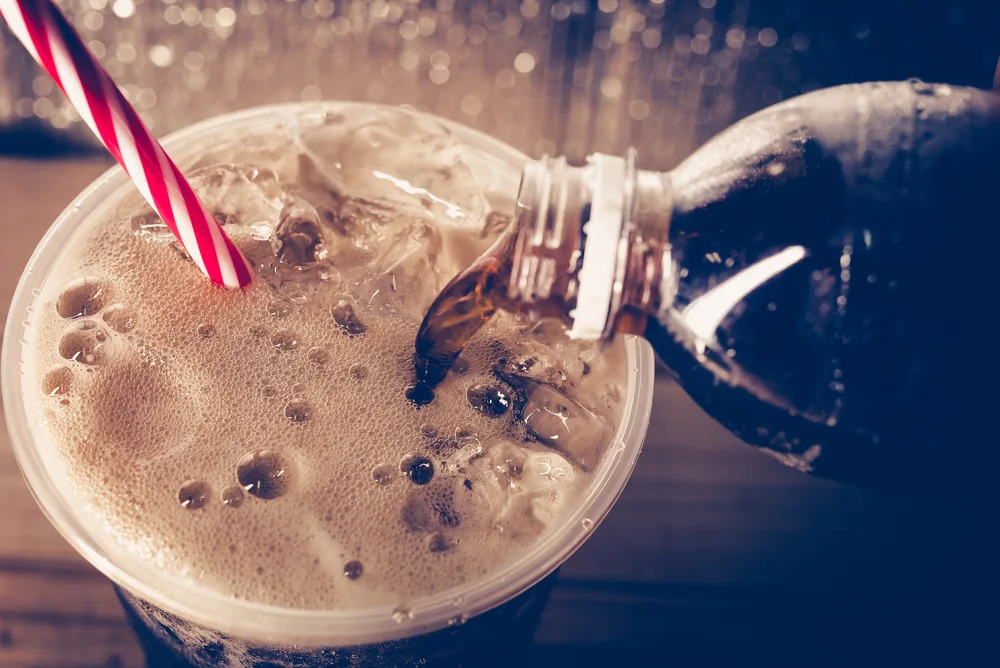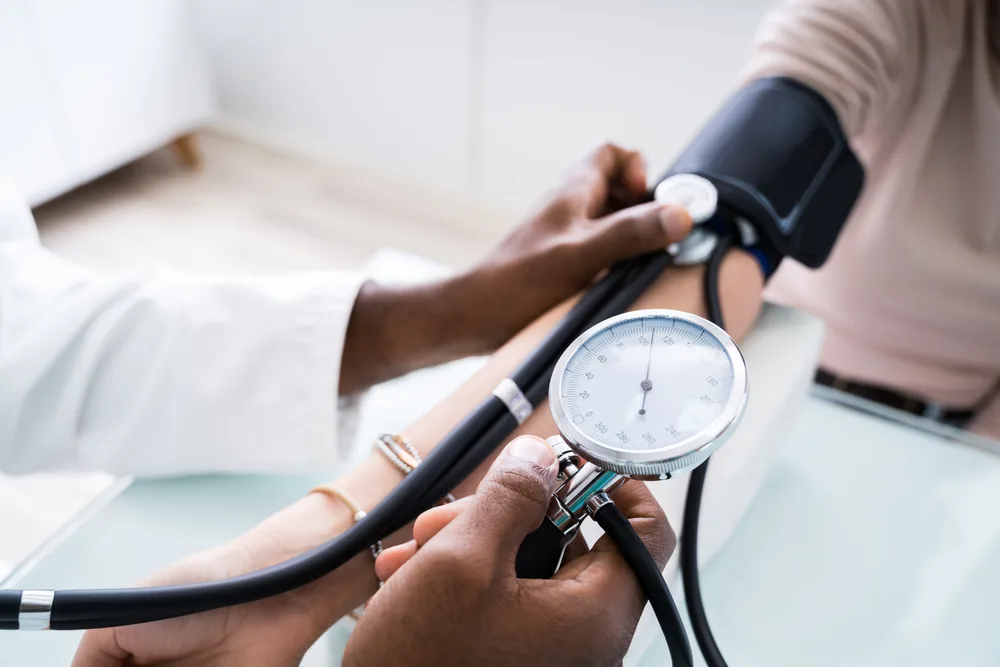Table of Contents
Dehydration can result in both low and high blood pressure. Reduced blood volume associated with dehydration contributes to the drop in blood pressure. In efforts to compensate, your body may increase blood pressure.
This article will explain exactly how and why your blood pressure changes in response to hydration levels and how males and females are affected differently.
How can dehydration cause low blood pressure (hypotension)?
What is blood pressure?

The American Heart Association (AHA) defines blood pressure as the pressure generated within vessels by the blood pushing against the walls of the arteries (1).
Two pressure (in mmHg) readings are noted during an assessment: the first is the pressure as the heart beats (systolic), and the second is the pressure in between heartbeats (diastolic) (1).
Blood pressure readings are written as a fraction with the systolic reading above the diastolic reading, e.g., 120 (systolic)/60 (diastolic) mmHg.
A systolic reading less than 90mmHg and diastolic less than 60mmHg indicate low blood pressure (hypotension) (2). In contrast, a reading of 130/80mmHg or higher indicates high blood pressure (hypertension) (1).
What is dehydration?
Dehydration is characterized by a decrease in the body’s water levels. It differs from volume depletion, which involves the loss of both salt and water.
Your body contains fluid both inside (intracellular) and outside (extracellular) its cells, with the majority found intracellularly. The extracellular distribution refers to the fluid around the cells and within the vessels. Water can move freely between these compartments.
You lose water from each of these compartments when dehydrated. The effect, however, is significant in the intracellular compartment because of its higher water content.
On the other hand, volume depletion refers to fluid loss from the extracellular spaces (3).
Does dehydration cause low blood pressure?
The amount of blood pumped out of the heart each minute and the resistance offered by the arteries receiving that blood determines your blood pressure. If either of these decreases, the blood pressure decreases and vice versa.
Think of a water hose: the more water you let in, the greater the water pressure. Similarly, the narrower the hose, the greater the pressure. Several factors can change your blood volume or affect the resistance in your arteries. This article will focus on the variations in blood volume.
The volume of blood pumped out of the heart each minute depends upon the amount of blood returning to the heart from the veins, the strength of the heart, the resistance in the vessels receiving blood, and the heart rate (4).
Dehydration (water loss) causes a significant water deficit in the intracellular rather than the extracellular compartment. Therefore, it rarely impacts your circulating blood volume.
However, as mentioned before, volume depletion (salt and water loss) leads to fluid loss from the extracellular compartment and, thus, a significant loss of circulating blood volume.
The loss of circulating blood volume reduces the amount of blood that returns to the heart, causing a drop in blood pressure. To compensate, the body t retains water and increases vascular resistance through vasopressin to maintain blood pressure.
Vasopressin is a hormone released by the brain in response to decreased blood volume or increased blood concentration. The effects of vasopressin may even result in raised blood pressure (5).
The terms dehydration and volume depletion are often used interchangeably. In fact, they may occur together in the body. Therefore, to simplify, we will refer to fluid loss from body compartments, whether it’s pure water or water with salt as dehydration (3).
Symptoms

Low blood pressure typically does not cause any symptoms and often goes unnoticed. However, people may experience symptoms associated with the underlying cause of hypotension.
Dehydration may cause thirst, dry mouth, dry skin, decreased peeing and sweating, dark-colored urine, fatigue, and dizziness in adults. In children, watch for signs such as dry mouth or tongue, less wet diapers, crying without tears, irritability, high fever, unusual sleepiness or tiredness, and sunken eyes (6).
Emergency signs
Your blood pressure may be too low if you experience dizziness, lightheadedness, confusion, headache, neck or back pain, fatigue, nausea, blurred vision, heart palpitations, rapid breathing, lack of urination, or fainting. It’s crucial to get a prompt evaluation for these (2, 6).
Who is more at risk?
Here are some groups that are more at risk of dehydration:
- Infants/young children
- Elderly
- Individuals using medication (e.g., diuretics)
- Individuals with chronic illnesses (e.g., diabetes, kidney disease, cystic fibrosis)
- Individuals exposed to hot temperatures (6)
Long-term effects on cardiovascular health?
Low blood pressure may be a sign of abnormal heart rhythm, problems with heart valves, a heart attack, or even heart failure (2).
Frequent or prolonged dehydration-induced low blood pressure may contribute to or worsen heart disease. If you are dehydrated, your heart works harder and beats faster to compensate for the low blood pressure.
The reduced blood volume also increases the viscosity (thickness) of the blood, making it even harder for the heart to pump blood into the vessels. Higher viscosity also increases the risk of developing blood clots.
In the long run, vasopressin, a hormone released by the brain in response to low blood volume or increased blood concentration, contributes to high blood pressure – a risk factor for heart disease (5).
Dehydration has also been linked to increased cholesterol levels, weight gain, and obesity, further increasing your risk of cardiovascular disease (7, 8).

Dehydration-induced hypotension in different genders
Now, we will take a closer look at how dehydration-induced hypotension manifests differently in women and men:
Gender-specific physiological differences
Due to generally shorter stature and smaller capacity for water storage, females typically have lower water mass than males. In addition, skeletal muscles store more water than fat tissue. Females have more fat tissue and less skeletal muscle mass than males.
Women also have less blood volume and a smaller proportion of body water in the extracellular compartment than men. In cases of comparable dehydration, where there is equal body mass loss, females experience more severe cardiovascular effects (9).
Female sex hormones play a role in regulating body fluid and electrolyte balance. Though still unclear, some evidence suggests that the later half of the menstrual cycle (from ovulation to menstruation) may lead to decreased blood volume due to fluid shifts influenced by these hormones (10).
In fact, estrogen and progesterone are present in high concentrations during this phase. While during the first half of the menstrual cycle, only estrogen levels are high (10).
During menopause, when the levels of estrogen and progesterone decrease, you are also more prone to dehydration. One study found lean body mass tends to decrease during the transition to menopause. This reduction in lean mass may result from changes in fluid dynamics during menopause, which are affected by declining estrogen levels (11).
The pregnant body undergoes several changes to adapt to the growing needs of the developing fetus. Maternal blood vessels dilate to increase blood flow while decreasing resistance and causing a subsequent fall in blood pressure, particularly in the first and second trimesters.
The blood pressure usually returns to pre-pregnancy levels by the third trimester. However, lying on their backs facing up can still put mothers at risk of hypotension during this time.
In this position, the weight of the uterus compresses a large vein that carries blood back to the heart, potentially reducing blood pressure. Lying on one side relieves the pressure of the uterus on this large vein (12).
Behavioral and lifestyle factors
A survey across 13 countries revealed that 60 percent of men and 40 percent of women did not meet the daily requirements for adequate water intake. Women were more than twice as likely as men to meet these requirements (13).
Psychological factors
Water drinking behaviors are influenced by the availability, quality, safety, and affordability of drinking water. The availability of other preferred drinks may reduce water intake. Besides that, toilet facilities, weather, and indoor climate also play a role.
Individual factors like thirst, understanding of the importance of water, personal habits, taste preference, and perceived benefit all influence water intake (14).
Which gender is more prone to low blood pressure at night?
It is normal physiology for both men and women to experience a decrease in blood pressure of greater than 10 percent and up to 20 percent at night (15).
Sleep quality, smoking, alcohol intake, use of blood pressure medication, the state of the body’s reflexes that control blood pressure variations, hormonal influences, and other diseases inter-play to determine the nighttime decrease in blood pressure. One study found that the nocturnal fall in blood pressure is more pronounced in women (15).
Differences in male vs female athletes
A lower total body water and blood volume in females compared to males means females have less fluid to lose by sweating. In addition, female sex hormones tend to retain fluid and sodium, further reducing sweat rates.
As a result, females experience a faster rise in core body temperature during exercise. They also rely on other means, like increased blood flow to the skin, to dissipate heat, which can cause a drop in blood pressure (9).
Hydration strategies


Hydration plays a pivotal role in regulating many bodily functions. Improper hydration or substitution of sugar-sweetened beverages to meet hydration needs can lead to several diseases even at a younger age. These include obesity, diabetes, metabolic syndrome, chronic kidney disease, and cardiovascular disease.
Preferred hydration strategies include meeting daily needs through food and water. Men require an estimated 15.5 cups of water daily, while women require 11.5 cups from food and beverage sources (16, 18).
We usually get sufficient electrolytes from our daily food and beverages, which are essential minerals regulating functions, such as blood pressure and water balance. While electrolyte drinks are not necessary for hydration, their supplementation may needed for children with a history of prolonged vomiting or diarrhea, individuals working long hours outdoors in hot and dry climates, or athletes involved in intense exercise. For exercise routines of moderate intensity lasting less than 75 minutes, plain water is usually sufficient (17).
Excessive intake of electrolyte drinks, in the form of sports drinks or electrolyte-infused water, can lead to electrolyte imbalances causing health issues.
Pregnant women, those with kidney disease, or those on blood pressure medication particularly need to be cautious while consuming any electrolyte beverage. If you have a medical condition, consider consulting a physician and have your electrolyte levels checked (17).
Males
The recommended daily intake of fluids for men is 13 cups (18).
Females
The recommended daily intake of fluids for women is 9 cups (18).
The American College of Obstetricians & Gynecologists advises aiming for 8 to 12 cups of water daily during pregnancy. Strategies include drinking throughout the day, not just when you feel thirsty (19).
Athletes
Weight, urine color, and thirst (WUT) can reliably assess hydration status. A decrease in body mass greater than 1 percent, dark-colored urine, or increasing thirst indicate inadequate hydration (20).
Hydrate before starting exercise, maintain it during training, and replenish any losses before another athletic routine. You may use the WUT criteria to assess your hydration levels before and after exercise to plan your hydration strategies.
The goal is to maintain optimal hydration, i.e., prevent dehydration while avoiding overhydration. The duration and intensity of exercise, environmental conditions such as temperature and clothing, fluids availability, and individual characteristics such as sweat rate and thirst dynamics all play a role in hydration.
Aim for a healthy weight, particularly if partaking in weight division (e.g., combat sports, horse racing, lightweight rowing, etc.), acrobatic (e.g., gymnastics, jumping, climbing, etc.), or appearance-based (e.g., cheerleading, gymnastics, body-building, etc.) sports. Avoid voluntary dehydration to achieve desired weight goals (21).
Rayven Nairn, a registered dietitian with a master’s degree from Johns Hopkins University, recommends the consumption of fruits such as pineapple or watermelon along with sports drinks or electrolyte-infused water and water-soluble vitamins (B vitamins and vitamin C). The goal is hydration maintenance for competitive athletes such as college athletes or long-distance runners (22).
Hypotensive patients with heart failure
People with heart failure are usually at risk of overhydration as the heart cannot properly pump blood, causing fluid backup and congestion in the body. That’s why these individuals typically use diuretics.
Diuretics, also known as water pills, cause you to pee more and thus help remove excess salt and water from the body. It is important to note, however, that dehydration may also occur with the use of diuretics, particularly if you have diarrhea, vomiting, or excessive sweating. Discuss with your physician if you need to adjust your diuretic dosage (23).
Does excessive hydration affect blood pressure?
Water toxicity, or excessive hydration, is a rare occurrence. It may manifest as an uncontrollable psychological urge to drink water, often observed in athletes who drink water after prolonged exercise without electrolytes or in water competitions.
Symptoms include confusion, lethargy, headache, and drowsiness. Besides that, high blood pressure and a low heart rate may occur as the brain swells due to excess water (24).



Does dehydration cause poor circulation?
Dehydration and low blood pressure cause poor circulation. In fact, dehydration reduces the blood volume, which decreases blood pressure.
A fall in blood pressure impairs the amount of nutrients and oxygen reaching the tissues.
Why does dehydration cause postural hypotension?
Postural changes, such as moving from lying to standing or sitting to standing, cause 300 to 800 ml of blood to pool in the lower limbs due to gravity.
Despite the decrease in blood returning to the heart, your body can sustain your blood pressure by activating relevant compensatory changes.
If you are dehydrated, your blood volume is already low. Postural changes reduce the volume of blood returning to the heart beyond the body’s ability to compensate. This leads to a drop in blood pressure (25).
Can diet and nutrition change hydration needs in men and women?
You receive around 20 percent of the water you need from the foods you consume. The recommended daily water for men is 15.5 cups, while women need around 11.5 cups of water obtained through food and beverages.
Fruits and vegetables have a high water content. Cantaloupe, strawberries, watermelon, bananas, grapes, oranges, pears, and pineapples are rich sources of water.
On the other hand, lettuce, cabbage, celery, spinach, cooked squash, carrots, broccoli, and avocados are good vegetable choices.
Dairy products such as yogurt, cottage cheese, and ricotta cheese can add hydration.
Plain water, sparkling water, and fat-free milk are good sources of beverages (18).
Does alcohol consumption affect hydration strategies for men and women differently?
Alcohol has a diuretic effect. It makes you pee more. This means that consuming significant amounts puts you at risk for dehydration (26).
The Dietary Guidelines for Americans 2020-2025 recommends limiting intake to two drinks or less a day for men and one drink or less a day for women.
The recommended intake is lower for females as the female body reacts differently to alcohol compared to males. Consuming similar amounts results in a higher blood concentration in women (27).
Summary
Dehydration may cause low blood pressure because of reduced circulating blood volume. This can have serious consequences as your body struggles to supply the tissues with sufficient oxygen and nutrients delivered by your blood.
Ensuring you meet the daily water intake requirements can help prevent dehydration. Men are required to drink an estimated 13 cups of water daily, while women are advised to consume 9 cups.

















Comments
0